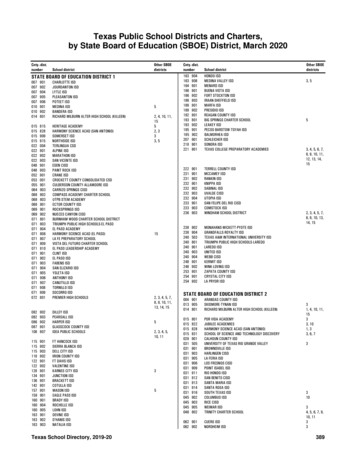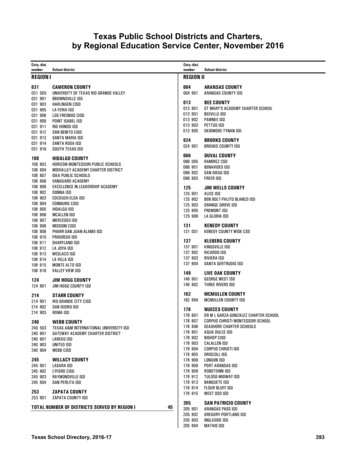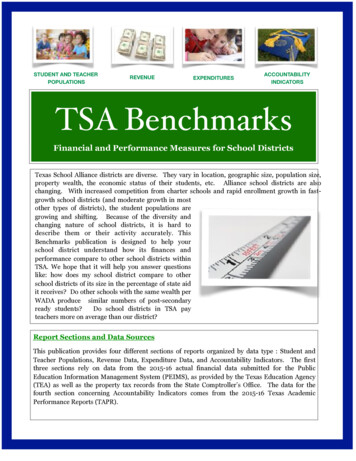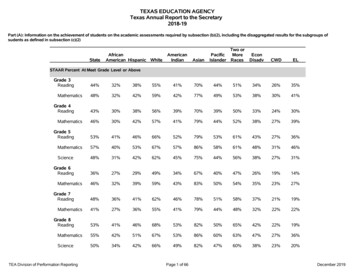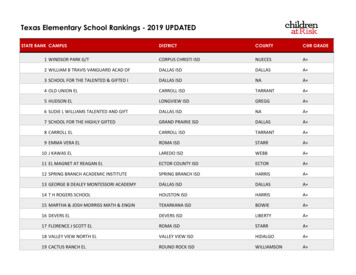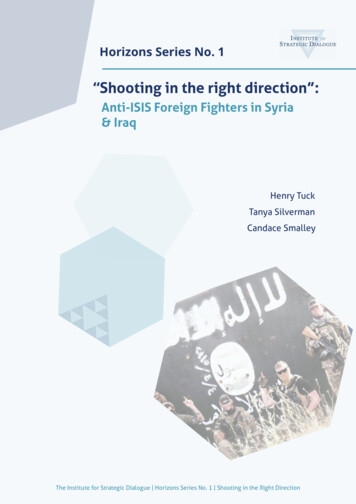
Transcription
Horizons Series No. 1“Shooting in the right direction”:Anti-ISIS Foreign Fighters in Syria& IraqHenry TuckTanya SilvermanCandace SmalleyThe Institute for Strategic Dialogue Horizons Series No. 1 Shooting in the Right Direction
About this paperThis report represents the first publication in ISD’s new “Horizons” series, launched to examineemerging trends related to violent extremism or CVE. Whilst the term “foreign fighter” is commonlyassociated with these individuals joining ISIS and other extreme Islamist groups, there has been far lessattention on the hundreds of other foreign fighters that have travelled to fight against ISIS. This reportbuilds on ISD’s research into the Islamist foreign fighter and female migrant phenomenon, and is basedon a dataset of 300 anti-ISIS foreign fighters. It sheds light on this understudied group, examining whothey are, who they are fighting with, and why they are prepared to participate in a far-away conflict. Italso considers the legal frameworks of the countries providing the largest numbers of anti-ISIS fightersand the possible future implications for the fighters themselves, as well as their national governments.About the authorsHenry Tuck is a Policy & Research Manager at the Institute for Strategic Dialogue (ISD). Henry currentlymanages the Institute’s educational programme, Extreme Dialogue, which aims to enhance criticalthinking skills and resilience among young people, and is involved across various projects to counterextremism online. He holds a Masters in International Conflict Studies from Kings College London anda BA from Durham University.Tanya Silverman coordinates the Against Violent Extremism (AVE) network at the Institute for StrategicDialogue. AVE is a partnership between ISD, Jigsaw (formerly Google Ideas) and the Gen Next Foundationwhich comprises of former extremists and survivors of extremism. Previously, she was involved acrossareas of the organisation’s security and counter-extremism work, particularly counter-narratives.Candace Smalley holds an MA from King’s College London in Terrorism, Security, and Society, a BScin Psychology from the University of Pittsburgh, and is pursuing an MS in Computer Science from theUniversity of Tulsa. Her research interests include interdisciplinary approaches to counter-terrorismand countering violent extremism.AcknowledgementsThe authors would like to thank Costan Barzanje and Hélène Trehin for all of their hard work in building the database. Theywould also like to thank Christopher Stewart, Jonathan Birdwell, Ross Frenett and Maud Piovesan for their support throughoutthe process. Finally, our sincerest gratitude is expressed to Kevin Knodell, a journalist for War Is Boring, who provided us withinterview transcripts and conversations with fighters in Syria. All errors and omissions are the sole responsibility of the authors.Cover photo & title quoteThe title quote is from American fighter, Matthew VanDyke, see endnote 114.Copyright 2016 Institute for Strategic Dialogue, All rights reserved. Any copying, reproduction or exploitation of the whole or anypart of this document without prior written approval from the Institute for Strategic Dialogue is prohibited.This material is offered free of charge for personal and non-commercial use, provided the source is acknowledged. For commercial orany other use, prior written permission must be obtained from the Institute for Strategic Dialogue. In no case may material be sold,altered, or rented. The Institute does not generally take positions on policy issues. This views expressed in this publication are thoseof the authors and do not necessarily reflect the views of the organisation.
Horizons Series No. 1“Shooting in the right direction”:Anti-ISIS Foreign Fighters in Syria& IraqHenry TuckTanya SilvermanCandace Smalley
Executive SummaryWhilst the phenomenon of travelling abroad to take part in war is not without historicalprecedents, the sheer volume of those attracted to the Syrian conflict has meantthat the issue has come to dominate the agendas of those tasked with counteringterrorism and radicalisation. Latest estimates suggest between 25,000 and 30,000Islamist foreign fighters have made the journey from over 100 countries around theworld, and between 4,000 and 7,000 from Western countries alone.1 The term 'foreignfighter' is commonly associated with these individuals joining ISIS and other extremeIslamist groups such as Jabhat al-Nusra. There has been far less attention paid to thehundreds of other 'foreign fighters' who have specifically travelled to fight againstISIS, predominantly from Western countries.Based on a dataset of 300 individuals, this report sheds light on this understudiedgroup of 'anti-ISIS foreign fighters', examining who they are, who they are fightingwith, and why they are prepared to participate in a far-away conflict. It also considersthe legal frameworks of the countries providing the largest numbers of anti-ISISfighters and the possible future implications for the fighters themselves, as well astheir national governments.Terms & methodologyThere are myriad groups involved in the Syrian conflict, including the Free Syrian Army,Assad-regime forces and Shia militias, Kurdish groups such as the YPG and Peshmerga,and of course extreme Islamist groups such as ISIS and Jabhat al-Nusra. In this report,we look at those 'foreign fighters' who travelled to join groups that are fighting againstISIS or Jabhat al-Nusra. For purposes of simplicity, we refer to them as 'anti-ISIS foreignfighters' given the prominence of ISIS in public and media discourse.Our database was built using a combination of primary open-source, self-reporteddata from the social media profiles of anti-ISIS fighters, complemented by mediareporting. As it was not always possible to find reliable information on each fighter, insome instances a full profile could not be constructed. Sources in English, French andGerman were used, with additional research conducted in Italian, Spanish, Turkish andKurdish. As a result the database represents a sample rather than a comprehensiveregister of all anti-ISIS fighters.Summary of findings1See: (December 2015) “Global Terrorism Index 2015” p.47 15/11/2015-Global-Terrorism-IndexReport.pdf; (December 2015) “Foreign Fighters: An Updated Assessment of the Flow of Foreign Fighters into Syria and Iraq” The Soufan Group p.5 TSG ForeignFightersUpdate3.pdf [Link last accessed 19/01/2016]i Institute for Strategic Dialogue
Who are the anti-ISIS foreign fighters? Anti-ISIS foreign fighters tend to be older than Islamist foreign fighters. A widerange of ages was observed among anti-ISIS foreign fighters, with the youngestonly 14 years old, and the oldest 67. The average age of the anti-ISIS fighters in thedataset was 32 years old, although the largest proportion of fighters were in their20s (48%) with median and modal ages of 28 and 26 respectively. On averageanti-ISIS foreign fighters were older than those joining Islamist groups. Anti-ISIS foreign fighters are less likely to include women or families, and thosewomen who are included appear to be more active in combat roles. While womenand girls comprise a substantial proportion of those joining extreme Islamistgroups (142 to 18%3), only 3% of those joining anti-ISIS groups are female.However, those that do are actively involved in combat roles, primarily with theall-female YPJ. Their counterparts joining ISIS are typically employed in domesticand matriarchal roles, with some also participating in propaganda activities orenforcing strict moral codes through the group’s all-female al-Khansaa Brigade.ISIS has also encouraged parents to take their children, with some large familygroups making the journey. With a single exception (a father and his teenage son)this was not a trend observed among anti-ISIS foreign fighters in the database. Over one in three anti-ISIS foreign fighters are American and often militaryveterans. The anti-ISIS fighters in the database originate from a total of 26predominantly Western countries, with the U.S. (38%), U.K. (14%), Germany (8%),France (6%), Sweden (6%) and Canada (5%) providing the largest proportions.The prevalence of Americans is largely explained by the number of U.S. militaryveterans. In contrast, estimates suggest that only around 6% of Islamist foreignfighters are from the U.S.4 Kurdish is the most common ethnicity among anti-ISIS foreign fighters. The largestself-identified ethnic minority group among the dataset were Kurdish (12%), witha small number of ethnically Assyrian and Yazidi fighters also present.Who are they fighting with? Syrian-Kurdish YPG (31%) and the Iraqi-Kurdish Peshmerga (22%) are the mostpopular groups among anti-ISIS foreign fighters. Others were found to be fightingwith Dwekh Nawsha (5.7%), an Assyrian Christian organisation, or the YPG’s allfemale YPJ units (1.3%). A small number of individual fighters were attached toHezbollah, the FSA, the PKK and various Shia militias. Just under half of the fighters(44%) were publically affiliated with others within the ISD database, suggestingthat anti-ISIS fighters are relatively well networked. The distribution of Islamist2Richard Barrett (2014) “Foreign fighters in Syria”. See also Claire Davis, Jasmine Opperman (2014) “Female foreign fighters Syria and Iraq” TRAC TerrorismResearch and Analysis Consortium ighters-syria-and-iraq3Peter Bergen, Courtney Schuster, David Sterman (November 2015) “ISIS in the West: The New Faces of Extremism” New America, 8 https://static. bae2e759.pdf [Link last accessed 22/02/2016]10 Ibid p.8-94Ibid p.8-9"Shooting in the right direction" ii
foreign fighters between groups is more concentrated than anti-ISIS foreignfighters who have a wider range of potential groups or units to join.Why are they fighting?Despite such a diverse group it is possible to identify common themes in themotivations of individual anti-ISIS foreign fighters. As in much of the research onIslamist foreign fighters, this report categorises observed motivations as either pushor pull factors. Push factors are manifested in an individuals’ dissatisfaction withtheir current circumstances or surroundings. Pull factors encompass what draws thatindividual to a particular conflict. These factors do not work in isolation. Instead, acombination of both push and pull factors usually must be present in order to finallyelicit the decision to travel.The overarching motives, goals, and hopes for the future of the region of anti-ISIS foreignfighters are diametrically opposed to their extreme Islamist counterparts. However,our research suggests that some of the more personal (rather than geopolitical) pushand pull factors that motivate foreign fighters are observed across both groups.Push factors Anti-ISIS foreign fighters are motivated by their frustrations with foreignpolicy and international responses to the conflict. The majority of anti-ISISforeign fighters regularly express their disappointment with existing responsesto the conflict, either from their respective national governments or the widerinternational community. This frustration is also observed among Islamists thatmake the journey, albeit in a vastly different way. This suggests that foreign policycan play an important role in the decision making processes of both foreign fightercohorts. Anti-ISIS foreign fighters are motivated by a desire for belonging and a lack ofpurpose in their lives. Foreign fighters on all sides can be driven by feelings ofalienation, isolation or boredom. Often these feelings can be exacerbated bypersistent unemployment, relationship difficulties, or simply a lack of purposeor direction in life. Such factors were observed across the dataset and were notexclusive to any particular group, although there were specific recurring issuesrelated to the reintegration of veterans following military service.Pull factors Anti-ISIS fighters are motivated by an altruistic desire to defend persecutedminority populations and defeat ISIS. The brutal propaganda produced by ISISappears to play an important role in recruiting anti-ISIS foreign fighters. Manydirectly state the impact of execution videos on their decisions to travel. The desireto protect persecuted minorities has a particularly strong impact on members of theiii Institute for Strategic Dialogue
transnational ethnic communities based in the region. For some this is exacerbatedby the presence of family members in the region, or even a family history of militaryinvolvement with one of the groups engaged in the current conflict. Ex-military veteran fighters are also motivated by a desire to ‘finish the job’ andensure previous sacrifices were not in vain. This is true primarily among militaryveterans that have served in the region during the 'War on Terror'. Many fear thattheir previous efforts, and those of their colleagues that were killed or injured, willbe in vain. Some also identify the region as a 'second home', having endured longdeployments during their time in the military. Anti-ISIS foreign fighters are motivated by an urge to fight, experience combat orare simply seeking an adrenaline-filled adventure. In some cases, fighters appearto be ill-informed about the conflict they have chosen to participate in, floatbetween various groups, or are simply seeking to defeat broadly defined conceptssuch as 'evil' or terrorism. Similar motivations can be observed among those whotravel to join ISIS, including thrill-seeking, searching for purpose, or even a desireto stand out from the crowd. Group dynamics and a sense of belonging and ‘family’also appears to play an important role for both foreign fighter cohorts.How are they recruited? Social media is used to recruit anti-ISIS foreign fighters, but recruitment andpropaganda is less professionalised, less proactive and less violent. Unlike theprofessionalised media centres of ISIS, anti-ISIS foreign fighters tend to rely onwebsites and social media groups, pages and individual profiles. There is anabsence of the explicitly violent material produced by the online Islamist foreignfighter community, although as would be expected there is a considerable amountof material denigrating their enemies. Unlike ISIS, the anti-ISIS online communitydoes not appear to actively groom potential recruits. However, there are concertedefforts to cultivate support by appealing to a collective sense of identity, pride orpersecution, and in doing so construct a humanitarian moral obligation to fight. Social media platforms are used more openly to network, raise funds and facilitatetravel, compared to Islamist groups like ISIS or Jabhat al-Nusra. The most popularsocial media platform used by anti-ISIS foreign fighters is Facebook, althoughprofiles and content are easily found on many other platforms including YouTube,Twitter and Instagram. The group most heavily recruiting online is the YPG. Amongthe most prominent pages is the 'Lions of Rojava', a collection of Westerners fightingalongside various YPG units. Anti-ISIS foreign fighters publically discuss theirexperiences and motivations in a more open way than their Islamist counterpartsare now able to, with fewer concerns about potential legal repercussions. Mediaappearances by anti-ISIS foreign fighters bolster their online profile, and theirsocial media accounts can act as a first point of contact for potential recruits."Shooting in the right direction" iv
Is it legal? The legality of participating in conflicts abroad as a private citizen remains alegally complex area and some governments appear reluctant to state clearlythe likely consequences for anti-ISIS foreign fighters. Often the laws applied toanti-ISIS fighters are closely related to (or the same as) those for foreign terroristfighters. A number of countries have recently updated their laws, but many stillfind they can be difficult or impractical to apply. Legality can hinge on the state’s current allegiances in the relevant conflict. Thecomplexity of the war in Syria and Iraq creates a situation whereby it is not alwaysclear under what circumstances anti-ISIS fighters could face legal sanctions. Thisincludes those fighting alongside groups such as the YPG that are working directlywith the international coalition in both Syria. A number of anti-ISIS fighters haveexpressed uncertainty over the possibility of legal repercussions on their return totheir country of origin. Levels of enforcement and prosecution therefore vary, and are often consideredon a case-by-case basis. Despite this, there are an increasing number of precedentsetting cases that are beginning to provide additional clarity in some contexts.Summary of recommendationsAlthough they do not pose the same potential threat as returning Islamist foreignfighters, returning anti-ISIS fighters may face similar risks. These risks can range fromlegal sanctions to physical or mental health problems, or difficulties reintegratingback into their former lives and communities, and if left unaddressed can create morelong-term, intractable issues.Governments need to reconsider whether existing support systems in place formilitary veterans are sufficient, but also whether they could be used to help returnees.Support for the families and parents of anti-ISIS foreign fighters, especially youth,could also be considered.Social networks should ensure they are aware of which groups involved in conflictsare using their platforms, and what they are using them for, in order to ensure they arenot violating their terms of service.iv Institute for Strategic Dialogue
“Shooting in the Right Direction”: Anti-ISIS Foreign Fighters in Syria & IraqI. Introduction – Definitions, Terms & Methodology4II. Demographics8 Age & gender8 Nationalities & regions8 Ethnicity & religion9 Education, employment & military service10 Who are they fighting with?10 How do they compare with Islamist foreign fighters?11III. Group Affiliations14 YPG and splinter groups14 Peshmerga and non-YPG affiliated Kurdish groups15 Dwekh Nawsha and Assyrian forces16 Outliers17i. Free Syrian Armyii. Pro-regime and Shia militias1718IV. Motivations20 21 Push Factorsi. Frustration with responses to the conflict21ii. Lack of belonging or purpose2224Pull Factorsi. Desire to make a differenceii. Diaspora fightersiii. Religious motivationsiv. Finishing the job24252627v. Adventure, adrenaline & aggression28V. Activities31 Media & recruitment31 Social media33
Funding37 Travel39 Roles in conflict40VI. Legal Framework43 Overview43 North America43 Europe44 Human rights violationsVII. Conclusions & Recommendations4748 The legality of foreign fighting48 Looking forward50 Possible issues for returneesRecommendations 5253i. Governmentsii. Social media and crowdfundingiii. Researchers545555
List of AcronymsFSAFree Syrian Army (al-Jaysh al-Sūrī al-Ḥurr)HMMWVHigh-Mobility Multipurpose Wheeled Vehicle (Humvee)IEDImprovised Explosive DeviceIRGCIslamic Revolutionary Guards Corps (Sepāh-e Pāsdārān-e Enqelāb-eEslāmi)ISISIslamic State of Iraq and al-ShamKRGKurdistan Regional Government (Hikûmetî Herêmî Kurdistan)MLKPMarxist-Leninist Communist Party (Marksist-Leninist KomünistPartisi)NPUNinevah Plain Protection UnitsPKKKurdistan Workers’ Party (Partiya Karkerên Kurdistanê)PSDProtective Services DetailPTSDPost-Traumatic Stress DisorderPUKPatriotic Union of Kurdistan (Yekîtiya Nîştimanî ya Kurdistanê)PYDDemocratic Union Party (Partiya Yekîtiya Demokrat)SOLISons of Liberty InternationalS-VBIEDSuicide Vehicle-Borne Improvised Explosive DeviceTBITraumatic Brain InjuryYPGPeople’s Protection Units (Yekîneyên Parastina Gel)YPJWomen’s Protection Units (Yekîneyên Parastina Jin )
1. IntroductionThe unprecedented influx of foreigners into Syria and then Iraq since 2011 is dominatedby those joining ISIS and other Islamist groups, as well as a significant number of Shiafighters.1 Although the scale of the influx is unprecedented, the current conflict inSyria and Iraq is by no means the first to attract overseas fighters to a particular causeor group. The most commonly cited historical precedents of foreigner fighters (onone or both sides) include the Spanish Civil War of the 1930s, the Afghan-Soviet Warof the 1980s, or the Balkan and Chechen conflicts of the mid-1990s. More recentlyforeign fighters have been involved in conflicts in Somalia, Yemen, Mali and Libya toname just a few.Although Islamist foreign fighters attract the majority of government concern andmedia interest, there are however also a number of anti-ISIS foreign fighters joiningother factions in the conflict, including those fighting against ISIS. These fighters,likely numbering in the hundreds and drawn from all over the world, could offervaluable insights into the decision making process of the predominantly youngpeople voluntarily participating in overseas conflicts, on either side. Although therehave been several media reports covering these fighters to-date there has been littlesystematic research into foreigners fighting against ISIS.2This report aims to provide insights into this group of fighters, examining who they are,who they are fighting for, and why they decided to volunteer. It builds on previous ISDresearch by drawing parallels between these anti-ISIS fighters and the foreign fightersand female migrants joining Islamist groups in terms of demographics, underlyingmotivations, recruitment pathways, online activities and combat roles.3 The legalcontext in the countries providing the most anti-ISIS fighters is also highlighted, alongwith some of the possible difficulties they may face on their return, legal or otherwise.Finally, the report offers a series of practical recommendations for governments andsocial media platforms, as well as identifying possible areas for future research.1Foreign fighters are not a new phenomenon in war. Thousands of foreign nationals have participated in numerous conflicts over the years, from the SpanishCivil War, to the resistance against the Soviet invasion of Afghanistan. Current estimates of the flow of foreign fighters into Iraq and Syria since 2011 suggestthat between 25,000 and 30,000 have travelled nearly 100 different countries, surpassing the 20,000 believed to have fought in Afghanistan. Westerncitizens are thought to number between 4000 and 7000. See: (December 2015) “Global Terrorism Index 2015” p.47“Foreign Fighters: An Updated Assessment of the Flow of Foreign Fighters into Syria and Iraq” The Soufan Group p.5 TSG ForeignFightersUpdate3.pdf [Link last accessed 19/01/2016]2Nathan Patin (August 2015) “The Other Foreign Fighters: An Open-Source Investigation into American Volunteers Fighting the Islamic State” 5/08/26/the-other-foreign-fighters/ [Link last accessed 19/02/2016]3Carolyn Hoyle, Alexandra Bradford, Ross Frenett (2015) “Becoming Mulan? Female Western Migrants to ISIS” Institute for Strategic Dialogue s/2016/02/ISDJ2969 Becoming Mulan 01.15 WEB.pdf ; Erin Saltman, Melanie Smith (2015) “Till MartyrdomDo Us Part” Institute for Strategic Dialogue; Rachel Briggs OBE, Tanya Silverman (2014) “Western Foreign Fighters: Innovations in Responding to the Threat”Institute for Strategic Dialogue [Link last accessed 19/02/2016]4 Institute for Strategic Dialogue
Definitions, Terms & MethodologyThe findings of this report are based on a database of 300 anti-ISIS fighters believedto have actively participated in the conflict in either Iraq or Syria, primarily fightingagainst ISIS, or made considerable attempts to travel to the region in order to do so.Those that attempted to travel were included if they were stopped en-route, butindividuals simply expressing a desire to travel were not. The database also includessome that have now returned to their home countries. Although in many cases it proveddifficult to verify the exact roles fulfilled by those in the database while in the theatreof war, all of those included have expressed a willingness to directly participate incombat if required. For the purposes of this report it was therefore decided to adoptthe term “anti-ISIS foreign fighters” to avoid confusion with the “foreign fighter” termcommonly associated with those joining ISIS or other extreme Islamist groups.ISD’s researchers built the database using a combination of available open-sources.In order to identify as many individuals as possible, an initial handful of prominentanti-ISIS foreign fighters were identified through media reports. This informationwas used to find the social media accounts of these individuals, and then a simple'snowball' technique was used to identify other anti-ISIS fighters within their onlinesocial networks. Once a fighter was identified, researchers would then return tomedia coverage to verify and supplement the information presented by anti-ISISfighters on social media. In the case of three fighters, information was also gatheredfrom original interview transcripts kindly shared with ISD.4 The information collectedwas then manually entered and coded into 30 distinct variables, encompassing basicdemographic information, education and employment histories, stated or inferredmotivations for travel, and affiliations with groups and other fighters within thedatabase.Whilst the database is extensive, there were a number of limitations to the researchmethodology employed for this study; The dataset represents a sample rather than a complete picture of the anti-ISISforeign fighters involved in the conflict in Iraq and Syria. The true number of antiISIS foreign fighters is extremely difficult to determine as, unlike Islamist foreignfighters, there are few estimates available from official sources, researchers or themedia. It was not always possible to find reliable information on each fighter for every datacategory, and therefore there are a number of 'unknowns' across most categories.Determining the affiliations of anti-ISIS fighters posed a particular challenge inthis respect, as many individuals within the database appeared to have split theirtime between several of the disparate groups and local units.4.War is Boring, Kevin Knodell - ll/ [Link last accessed 19/02/2016]"Shooting in the right direction" 5
Similarly, whilst researchers attempted to assign the motivations of fighters tovarious broad categories, this was typically an imprecise exercise. This reporttherefore does not rely on these categorisations to infer accurate statistics aroundthe motivations of fighters in the database. Instead, this information is used toprovide an overview of the most frequently cited reasons for fighters’ participation. Every care was taken to ensure there was no repetition of individuals in thedatabase by cross-referencing social media accounts with available news reporting.However, due to the widespread adoption of noms de guerre and use of multiplesocial media accounts among fighters, there is the possibility that some individualsmay have been double-counted. Data collection was also somewhat limited in scope by the languages spoken byISD’s researchers. Primarily sources in English, French and German were considered(as well as some Italian and Spanish sources), with Turkish and Kurdish sourcesalso included to supplement research on anti-ISIS Western fighters with Turkishor Kurdish roots. As a result, the overwhelming majority of those featured in thedatabase originate from particular Western or European countries, with a fewnotable exceptions. This report does not examine at length non-Western foreign Shia fighters supportingthe Assad regime in Syria, or fighting against ISIS in Iraq. The majority of foreignShia fighters are mobilised from Lebanon, Iraq or Afghanistan and the militias theytypically join often maintain ties to Iran. There were however a small number ofindividuals included in the dataset from the U.S., Canada and Norway affiliatedwith Hezbollah or Shia militias.5 As a result of the primary open-source, self-reported nature of the data collected,the sample of fighters within the database mostly includes those that have sharedinformation of their activities publically, either online or via the media. There aremany additional fighters that have chosen not to publicise their participation inthe conflict, most likely as a result of fears around either operational security orthe legal repercussions they may face on their return to their countries of origin.It should also be stated that many of the fighters that are more open about theiractivities may have an interest in misrepresenting their contributions on theground. ISIS fighters have often portrayed an idealised snapshot of the realitiesof life in the 'caliphate' online. In a similar way, a number of the anti-ISIS foreignfighters featured in the database have typically posted positive content aroundtheir experiences. Others are directly involved in the recruitment of potentialfighters, or assisting in facilitating their journey to the frontlines of the conflict,and therefore have a possible incentive to present more positive perspectives tothe outside world.Finally, a note on the various fighters mentioned or featured within this report. All of5.Canada, See; Stewart Bell (May 2014) “Canadian terrorist, who was a senior Hezbollah member, killed by Syrian rebels” National Post ian-rebels [Link last accessed 19/02/2016] Norway, See;(02/02/2015) “14-year-old Norwegian found fighting in Iraq” The Local.No http://www.theloca
women who are included appear to be more active in combat roles. While women and girls comprise a substantial proportion of those joining extreme Islamist groups (142 to 18%3), only 3% of those joining anti-ISIS groups are female. However, those that do are actively involved in combat roles, primarily with the all-female YPJ.

